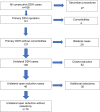Day-case open reduction for developmental dysplasia of the hip
- PMID: 33904319
- PMCID: PMC8085615
- DOI: 10.1302/2633-1462.24.BJO-2020-0199.R2
Day-case open reduction for developmental dysplasia of the hip
Abstract
Aims: Open reduction in developmental dysplasia of the hip (DDH) is regularly performed despite screening programmes, due to failure of treatment or late presentation. A protocol for open reduction of DDH has been refined through collaboration between surgical, anaesthetic, and nursing teams to allow same day discharge. The objective of this study was to determine the safety and feasibility of performing open reduction of DDH as a day case.
Methods: A prospectively collected departmental database was visited. All consecutive surgical cases of DDH between June 2015 and March 2020 were collected. Closed reductions, bilateral cases, cases requiring corrective osteotomy, and children with comorbidities were excluded. Data collected included demographics, safety outcome measures (blood loss, complications, readmission, reduction confirmation), and feasibility for discharge according to the Face Legs Activity Cry Consolidability (FLACC) pain scale. A satisfaction questionnaire was filled by the carers. Descriptive statistics were used for analysis.
Results: Out of 168 consecutive DDH cases, 16 patients fit the inclusion criteria (age range 10 to 26 months, 13 female). Intraoperative blood loss ranged from "minimal" to 120 ml, and there were no complications or readmissions. The FLACC score was 0 for all patients. The carers satisfaction questionnaire expressed high satisfaction from the experience with adequate information and support provided.
Conclusion: Open reduction in DDH, without corrective osteotomy, is safe and feasible to be managed as a day case procedure. It requires a clear treatment pathway, analgesia, sufficient counselling, and communication with carers. It is even more important during the COVID-19 pandemic when reduced length of hospital stay is likely to be safer for both patient and their parents. Cite this article: Bone Joint Open 2021;2(4):271-277.
Keywords: DDH; Day-case; Open reduction.
Conflict of interest statement
Figures
Similar articles
-
Comparison of total cost and outcomes between single-stage open reduction and Pemberton periacetabular osteotomy operation and two separate consecutive operations in treatment of bilateral developmental hip dysplasia in children at walking age.J Pediatr Orthop B. 2020 May;29(3):256-260. doi: 10.1097/BPB.0000000000000714. J Pediatr Orthop B. 2020. PMID: 31923136
-
A protocol for the use of closed reduction in children with developmental dysplasia of the hip incorporating open psoas and adductor releases and a short-leg cast: Mid-term outcomes in 113 hips.Bone Joint J. 2016 Nov;98-B(11):1548-1553. doi: 10.1302/0301-620X.98B11.36606. Bone Joint J. 2016. PMID: 27803233
-
[Single-stage bilateral Pemberton's pericapsular osteotomy in bilateral developmental dysplasia of the hip].Acta Orthop Traumatol Turc. 2002;36(4):288-94. Acta Orthop Traumatol Turc. 2002. PMID: 12510062 Clinical Trial. Turkish.
-
Cochrane Review: Screening programmes for developmental dysplasia of the hip in newborn infants.Evid Based Child Health. 2013 Jan;8(1):11-54. doi: 10.1002/ebch.1891. Evid Based Child Health. 2013. PMID: 23878122 Review.
-
Developmental dysplasia of the hip: update of management.EFORT Open Rev. 2019 Sep 17;4(9):548-556. doi: 10.1302/2058-5241.4.180019. eCollection 2019 Sep. EFORT Open Rev. 2019. PMID: 31598333 Free PMC article. Review.
References
-
- Dorn U, Neumann D. Ultrasound for screening developmental dysplasia of the hip: a European perspective. Curr Opin Pediatr. 2005;17(1):30–33. - PubMed
-
- Paton RW. Screening in developmental dysplasia of the hip (DDH). Surgeon. 2017;15(5):290–296. - PubMed
-
- No authors listed . Newborn and infant physical examination (NIPE) screening programme handbook. Public Health England. 2020. https://www.gov.uk/government/publications/newborn-and-infant-physical-e... (date last accessed 9 June 2020)..
-
- Wright J, Tudor F, Luff T, Hashemi-Nejad A. Surveillance after treatment of children with developmental dysplasia of the hip: current UK practice and the proposed Stanmore protocol. J Pediatr Orthop B. 2013;22(6):509–515. - PubMed
LinkOut - more resources
Full Text Sources
Research Materials





